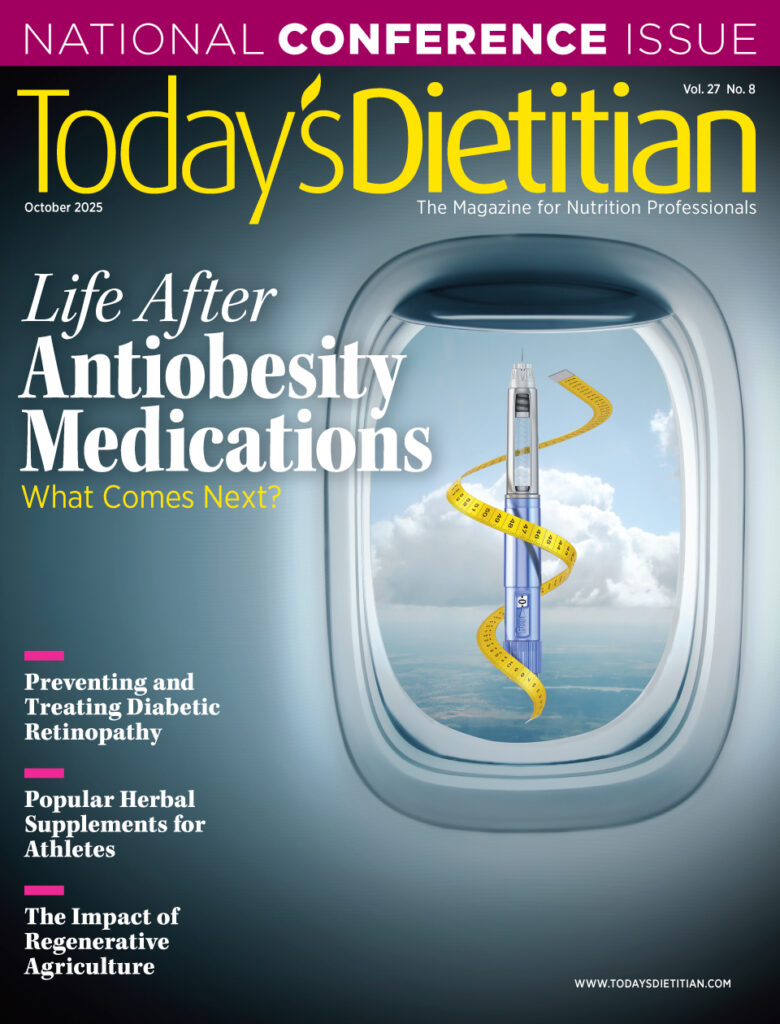Today’s Dietitian
Vol. 27 No. 7 P. 10
As summer winds down and the back-to-school season ramps up, parents and caregivers often find themselves juggling school drop-offs, extracurriculars, and the daily challenge of getting meals—and snacks—on the table. In the search for convenience, home-delivery meal kits may seem like a good answer. With preportioned ingredients and delicious-sounding, step-by-step recipes, they promise to simplify mealtime. But while these kits offer ease in theory, the reality is often more complicated. The good news: Another option might already be on hand—in the freezer.
The Hidden Downside of Meal Kits
Meal kits can streamline meal planning and even turn dinner preparation into a fun, collaborative family cooking activity—a win in many households. But they don’t always deliver on their promise of simplicity. The drawbacks can outweigh the benefits:
• Price: The cost per serving varies by brand and plan size. For example, HelloFresh charges $10.99 per serving for a four-meal, four-person plan. Most services also tack on a shipping fee, and some may require home cooks to have basic staples (like oil, butter, eggs, or salt) on hand. The cost can add up quickly for larger families or frequent orders.
• Packaging: Individually wrapped ingredients, insulation, cold packs, and boxes can generate a surprising amount of recycling and trash.
• Prep and cleanup: Most kits include raw ingredients that still need to be chopped, cooked, and cleaned up—tasks that can feel daunting on a busy school night. And not all recipes are one-pot or one-pan dinners, so home cooks may find themselves juggling multiple pans and lots of dirty dishes.
The Freezer: A Smarter, Simpler Solution
Instead of turning to meal kits, dietitians can help clients rethink the value of their home freezer. A well-stocked freezer with ready-to-use ingredients can make fast, nutritious meals and snacks possible—with less cost and less waste.
• Budget-friendly: Frozen fruits and vegetables are often more affordable than fresh, especially when out of season. For example, at one major retailer, a 16-oz bag of frozen strawberries was priced at $2.49, compared with $3.49 for fresh and $5.99 for fresh organic.
• Reduced Spoilage: According to the USDA, the average American family of four throws away about $1,500 worth of food every year.1 In their 2025 US Food Waste Report, ReFED (Rethink Food Waste Through Economics and Data) reports that frozen foods are among the least wasted food category, making up just 2.3% of total food waste compared with 43.7% for fresh produce.2
• Nutrient retention: Frozen fruits and veggies are usually picked at their peak of ripeness and frozen within hours, often right near the farm. That quick trip from field to freezer helps lock in nutrients and keep quality high.3-5
Freezer Staples That Work Hard
Clients don’t need a walk-in freezer to make this strategy work. A few versatile ingredients can go a long way toward building balanced meals and snacks:
• Proteins: Frozen shrimp, salmon burgers, meatballs (turkey, beef, or plant-based), individually frozen chicken breasts or tenders, diced cooked chicken, cooked lentils (available at select stores), ravioli, manicotti, or tortellini.
• Vegetables: Broccoli florets, bell pepper strips, edamame, peas, corn kernels, butternut squash, chopped spinach or kale, cauliflower rice, mixed vegetables, and stir-fry blends.
• Fruits: Berries (blueberries, strawberries, raspberries, or mixed berries), mango chunks, pineapple tidbits, tropical fruit blends with banana, and avocado.
• Grains: Brown or wild rice, quinoa, and grain medleys.
• Flavor enhancers: Frozen garlic and ginger cubes, herb cubes (like basil or cilantro, available at select stores), and chopped onions.
With a variety of ingredient basics on hand, it can be easy to build quick meals and snacks—no washing or chopping required. In addition, home cooks can use only what they need, such as half a bag of frozen broccoli florets in a stir-fry or half a cup of frozen mango for a smoothie, and return the rest to the freezer without worrying about spoilage, unlike fresh produce that too often gets pushed to the back of the refrigerator and forgotten.
That said, it’s worth explaining to clients how to avoid freezer burn, which can happen when frozen food is exposed to air, causing dry, grayish-white spots to form. It’s not harmful, but freezer burn can affect the food’s texture and flavor. To prevent it, press out as much air as possible before resealing the original bag, or transfer leftovers to a freezer-safe zip-top bag or an airtight container. For extra protection, consider placing the sealed bag inside a second container or bag to block exposure to air. It’s also important to maintain a freezer temperature at or below 0˚F (-18˚C).6,7
Simple Recipes That Deliver
While dietitians often encourage clients to choose fresh, seasonal produce—and for good reason—frozen options offer a comparable nutrient profile with added benefits: convenience, affordability, and a longer shelf life. With the right freezer staples on hand (and a variety of pantry and fridge basics), families can quickly assemble nourishing meals and snacks without the added cost or packaging of a meal kit. The following three recipes are easy to prepare, freezer-forward, and ideal for busy days when time is short and appetites are big.
— Liz Weiss, MS, RDN, shares recipes and healthful living advice on LizsHealthyTable.com and her podcast, EAT, DRINK, LIVE LONGER. Weiss is a cooking instructor, frequent lifestyle guest on TV shows across the country, and a recipe developer and cookbook author.
Ravioli & Spinach Lasagna
Total prep and cook time: 1 hour 15 minutes
Yield: 6 servings
Frozen cheese ravioli gets layered with chopped frozen spinach, marinara, and melty cheese for a no-fuss take on lasagna. This hearty comfort food casserole is family-friendly and endlessly adaptable—try frozen mushroom, meat, or butternut squash ravioli for a tasty riff.
Ingredients
3 cups frozen chopped spinach, thawed, drained, and pressed dry
1 cube frozen crushed garlic, thawed
1 (24-oz) jar marinara sauce
1 (22- to 25-oz) bag frozen cheese ravioli
1/3 cup finely chopped fresh basil, plus more for garnish
11/2 cups shredded part-skim mozzarella cheese
1/4 cup water
Directions
1. Preheat oven to 375˚F. Lightly coat 9×13-inch baking dish or pan with nonstick spray.
2. Place spinach and garlic cube in bowl and mix to combine.
3. Spoon 3/4 cup marinara sauce into bottom of baking dish and spread evenly. Layer half of frozen ravioli in single layer over sauce.
4. Spread spinach mixture evenly over ravioli and sprinkle with half of chopped basil. Top evenly with 3/4 cup shredded mozzarella and another 3/4 cup marinara sauce.
5. Add remaining ravioli in single layer. Spoon remaining 1 cup marinara evenly over top layer of ravioli. Add 1/4 cup water to empty sauce jar, secure lid, and shake to loosen any remaining sauce. Pour water-sauce mixture over ravioli.
6. Sprinkle with remaining basil and 3/4 cup shredded mozzarella. Cover dish tightly with aluminum foil and bake about 40 minutes, until bubbly. Uncover and bake an additional 10 to 15 minutes, until cheese is melted, casserole is bubbly, and ravioli are tender.
7. Let rest 5 to 10 minutes before slicing and serving. Garnish with extra basil, as desired.
Nutrient Analysis per Serving (1/6 casserole)
Calories: 330; Total fat: 13 g; Sat fat: 5 g; Cholesterol: 40 mg; Sodium: 600 mg; Total carbohydrate: 35 g; Total sugars: 6 g; Added sugars: 2 g; Dietary fiber: 4 g; Protein: 16 g
Gorgeous Green Smoothie
Total prep and cook time: 5 minutes
Yield: 2 servings
This nourishing smoothie comes together in minutes using freezer essentials like mango, spinach, and ginger. The ingredients are flexible—try frozen pineapple instead of mango or swap in chopped frozen kale for spinach, depending on what you have stocked.
Ingredients
1 cup 2%-reduced-fat milk or plain soymilk
3/4 cup 100% orange juice
1/2 cup frozen mango chunks
1/2 cup frozen chopped spinach
1/2 ripe banana
2 cubes frozen crushed ginger
Directions
1. Place milk, orange juice, mango, spinach, banana, and ginger in blender, and blend until well combined.
2. Pour into individual glasses and serve.
Nutrient Analysis per Serving (1¼ cups)
Calories: 170; Total fat: 6.3 g; Sat fat: 3.2 g; Cholesterol: 10 mg; Sodium: 80 mg; Total carbohydrate: 32 g; Total sugars: 24 g; Added sugars: 0 g; Dietary fiber: 2.7 g; Protein: 6 g
Teriyaki Shrimp & Broccoli Stir-Fry
Total prep and cook time: 15 minutes
Yield: 4 servings
Protein-packed shrimp and vitamin C-rich broccoli team up in this fast stir-fry. With shrimp already peeled and deveined and veggies prepped and frozen, the heavy lifting is done before you even turn on the stove.
Ingredients
1/3 cup less-sodium teriyaki sauce
1 tsp cornstarch
2 T canola or other neutral oil, divided
1 (16-oz) bag frozen broccoli florets, thawed
2 cubes frozen crushed garlic, thawed
2 cubes frozen crushed ginger, thawed
1 (16-oz) bag peeled and deveined frozen shrimp, thawed
2 cups frozen brown rice, cooked according to package directions
Optional toppings: Sesame seeds, fresh cilantro, chopped green onion
Directions
1. Place teriyaki and cornstarch in small bowl and whisk to combine. Set aside.
2. Heat 1 T oil in large nonstick skillet or wok over medium-low heat. Add broccoli, garlic, and ginger and cook, stirring often, until ginger and garlic are fragrant and broccoli is crisp tender, 3 to 5 minutes. Remove and set aside in bowl.
3. Add remaining T oil to skillet. Add shrimp and cook until golden on bottom, 2 minutes. Flip and cook 1 more minute.
4. Add broccoli back to skillet. Rewhisk teriyaki/cornstarch mixture. Stir into skillet until broccoli and shrimp are well coated and sauce thickens slightly, 1 minute. Serve over cooked rice and top with optional toppings, as desired.
Nutrient Analysis per Serving (21/2 cups)
Calories: 210; Total fat: 14 g; Sat fat: 1.5 g; Cholesterol: 170 mg; Sodium: 590 mg; Total carbohydrate: 20 g; Total sugars: 5 g; Added sugars: 2.7 g; Dietary fiber: 4 g; Protein: 25 g
References
1. Food loss and waste. USDA website. https://www.usda.gov/foodlossandwaste/consumers
2. From surplus to solutions: 2025 ReFED U.S. Food waste report. ReFED website. https://refed.org/uploads/refed-us-food-waste-report-2025.pdf?_cchid=3f68e988d1f538626f8069df6771e1df
3. Bouzari A, Holstege DM, Barrett DM. Vitamin retention in eight fruits and vegetables: a comparison of refrigerated and frozen storage. J Agric Food Chem. 2015;63(3):957-962.
4. Li L, Pegg RB, Eitenmiller RR, Chun JY, Kerrihard A. Selected nutrient analyses of fresh, fresh-stored, and frozen fruits and vegetables. J Food Compos Anal. 2017;59:8-17.
5. Bouzari A, Holstege DM, Barrett DM. Recent developments in freezing of fruits and vegetables: striving for quality and safety. J Food Sci. 2023;88(1):5-16.
6. Freezing basics. University of Missouri website. https://extension.missouri.edu/publications/gh1501
7. Freezing and food safety. USDA website. https://www.fsis.usda.gov/food-safety/safe-food-handling-and-preparation/food-safety-basics/freezing-and-food-safety



